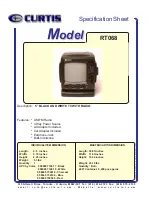
11
2.7 BEFORE STARTING THE GENERATOR
Prior to operating the generator, engine oil and gasoline will need to be
added, as follows:
2.7.1 ADDING ENGINE OIL
All oil should meet minimum American Petroleum Institute (API) Service
Class SJ, SL or better. Use no special additives. Select the oil's viscosity
grade according to the expected operating temperature (also see chart).
• Above 40° F, use SAE 30
• Below 40° F and down to 10° F, use 10W-30
• Below 10° F, use synthetic 5W-30
Any attempt to crank or start the engine
before it has been properly serviced with the
recommended oil may result in an engine failure.
1 0 W - 3 0
1 0 W - 3 0
S A E 3 0
S A E 3 0
S y n t h e t i c 5 W - 3 0
S y n t h e t i c 5 W - 3 0
1. Place generator on a level surface (not to exceed 15° in any
direction).
2. Clean area around oil fill and remove oil fill cap and dipstick. Dipstick
is accessible from the top of the unit next to the lifting eye in the
U-shape of the fuel tank.
3. Wipe dipstick clean; reinsert and remove dipstick and check oil level
against marks on dipstick.
4. If required, slowly fill engine with oil through the oil fill opening until
it reaches the full mark on the dipstick. Stop filling occasionally to
check oil level.
Do not overfill.
5. Install oil fill cap and finger tighten securely.
6. Reinsert dipstick and seat firmly.
7. Check engine oil level before starting each time thereafter.
2.7.2 ADDING
GASOLINE
Never fill fuel tank indoors. Never fill fuel tank
when engine is running or hot. Allow unit/engine
to cool entirely before adding fuel. DO NOT light a
cigarette or smoke when filling the fuel tank.
Do not overfill the fuel tank. Always leave room
for fuel expansion.
.
To reduce lead and carbon deposits use high quality UNLEADED
gasoline with the generator engine. Leaded REGULAR grade
gasoline is an acceptable substitute. Do not use premium gasoline.
Do not mix oil with gasoline.
2. Clean area around fuel fill cap, remove cap.
3. Slowly add unleaded regular gasoline to fuel tank.
Be careful not to
overfill.
Allow about 1/2" of tank space for fuel expansion, as shown
in Figure 16.
4. Install fuel cap and wipe up any spilled gasoline.
Figure 16 - Fuel Tank
IMPORTANT:
It is important to prevent gum deposits from forming in fuel
system parts such as the carburetor, fuel hose or tank during storage.
Alcohol-blended fuels (called gasohol, ethanol or methanol) can attract
moisture, which leads to separation and formation of acids during storage.
Acidic gas can damage the fuel system of an engine while in storage. To
avoid engine problems, the fuel system should be emptied before storage
of 30 days or longer. See the "Storage" section. Never use engine or
carburetor cleaner products in the fuel tank as permanent damage may
occur.
The manufacturer does not recommend using any
gasoline containing alcohol (such as “gasohol”).
If using any gasoline containing alcohol, it must
not contain more than 10 percent ethanol, and
it must be removed from the generator during
storage. Do NOT use any gasoline containing
methanol. If using gasoline with alcohol,
inspect more frequently for fuel leaks and other
abnormalities.
2.8 TO START THE ENGINE
Never start or stop engine with electrical devices
plugged into the receptacles AND devices turned
on.
1. Unplug all electrical loads from the unit's receptacles before starting
the engine.
2. Make sure the unit is in a level position (not to exceed 15° in any
direction).
3. Open the fuel shut-off valve (Figure 17).
Operation














































